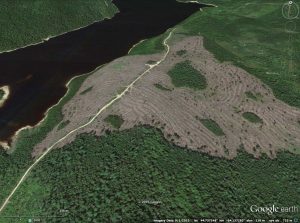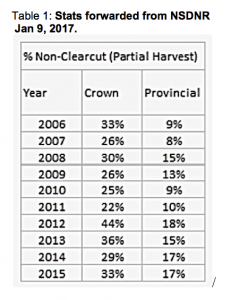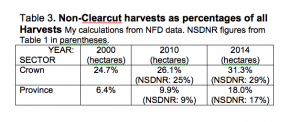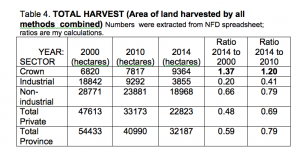The answer may depend on what and who you ask.
With the release of the Five-year Progress Report for the Natural Resources Strategy for Nova Scotia 2011-2020 in August, the government announced that the goal of reducing clearcutting on Crown land to 50% of all harvests was no longer relevant as “ the decision to clearcut (or not) has to be made in a larger context… [and] We have now developed tools that ensure that all harvest treatments are aligned with the nature-based requirements of Nova Scotia’s lands.”
However, it seems that percentages are relevant again. A friend received these stats, forwarded from NSDNR by a MLA in response to concerns he had expressed about clearcutting:
There was no descriptive text to accompany the numbers. I guess they are intended to show that about 1/3rd of Crown land is not clearcut, and that for the Province as a whole the percentage non-clearcut, while less than for Crown lands, has increased.
In a separate letter responding to queries by another concerned citizen, Lloyd P. Hines (Minister of Natural Resources) wrote: ”Data collected by the department from Registered Wood Buyers and private forest industry in the province indicate that non-clearcut harvesting methods have increased 8 percent and the amount (hectares) of clearcut harvesting has decreased 23 percent since 2010.”
NSDNR, apparently, wants to reassure Nova Scotians that the concerns expressed in numerous letters, editorials, blogs etc about increased clearcutting in Nova Scotia, especially on Crown lands, are not backed up by the facts.
I have been watching TV ads about how sustainable the forest industry is in our province. I have also seen first-hand the hundreds of acres of Crown land in my area being decimated by clear-cutting.” Voice of the People, CH Jan 19, 2017
To get a clearer picture of what is happening, I consulted the more comprehensive stats given in The National Forestry Database: Canada’s Compendium of Forestry Statistics, which collates CFS data from “provincial or territorial resource management organizations [and].. responsible federal departments.”
The numbers in the tables below were extracted from a spreadsheet of stats on Area Harvested by Ownership and Harvesting Methods for Nova Scotia (The spreadsheet gives stats for years 1990 to 2014; it is available as a webpage or as an Excel file.)
Here are NFD (National Forestry Database) numbers for 1 and 2-stage clearcuts for Nova Scotia:
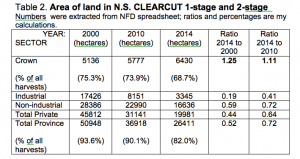
The clearcuts expressed as a percent of all harvests declined 2000-2010-2014, more so between 2010 and 2014. (See Table 4 below for Total Harvest stats.)
The percentages of non-clearcuts calculated from the NFD data changed correspondingly:
Although the calculated percentages of Non-Clearcuts do not agree precisely with those forwarded from NSDNR for 2010 and 2014 (Table 1 above), they are close enough. (The differences may be due to some 2-stage clearcuts being included in the NFD tabulation, but being considered non-clearcuts under the NSDNR scheme.)
So, OK, the percentage of Non-Clearcut land has been between 1/4 and 1/3rd of all cuts on Crown Land and, while less, has been showing some increase for the province as a whole.
The Minister of Natural Resources also wrote that the “amount (hectares) of clearcut harvesting has decreased 23 percent since 2010,” referring to “Data collected by the department from Registered Wood Buyers and private forest industry in the province”.
The NFD numbers in Table 2 above indicate that the total area clearcut (1-stage and 2-stage) for the province as a whole in 2014 was 72% of that in 2010, i.e. a reduction of 28%. This is a larger figure than that given by Hines for 2010 to 2015 or 2016 (23%) but they are in the same ball park, and either way it’s a substantial reduction.
However, it’s important to note that the reduction in clearcutting is related mostly to greatly reduced forest harvesting overall. The following table shows NFD numbers for Total Harvests:
For the province as a whole, the total harvest in 2014 was 79% of that in 2010, i.e. a reduction of 21%. The reduction in clearcutting cited above was 28%, so most (~3/4) of the reduction was due to lower harvests overall; a quarter of it might be attributed to changing practices.
The declines in forest harvests overall underscore the continuing decline in the total dollar value of the forest economy in Nova Scotia. The decline from peak years in the late 1990’s/2000 to 2010 is well documented in the 2011 Woodbridge Report for both sawmills and pulp and paper; a Woodbridge 2015 report indicates some recovery in the period 2010-2014 which is not reflected in the numbers above.
What stands out in these numbers, however, is the substantive increase in the area of Crown land harvested (clearcut and total) over both intervals (2000-2010 and 2010-2014). This increase is in marked contrast to large declines for industrial and non-industrial private lands.
When Minister Hines stated that “the amount (hectares) of clearcut harvesting has decreased 23 percent since 2010”, he was referring to the province as a whole, and avoided to mention the increase on Crown lands.
Simply stated, the numbers that Minister Hines/NSDNR presented to refute concerns about clearcutting do not tell the whole story, especially in regard to Crown lands. The more complete numbers available on the National Forest Database appear to confirm public perceptions that Crown land harvesting has increased.
Even those (NFD) numbers still leave a lot of questions unanswered, e.g. Why has NSDNR increased cutting on Crown lands so much when overall demand for wood products has declined? Why has the use of Industrial Lands declined so much? Is there a connection…? See: 2015 stats for Nova Scotia on National Forestry Database illustrate continuing pressure on Crown lands (Post, Apr 4, 2017) for some further comments on this question.
—————–
This blog post is the 1st of three in a series that explore the apparent contradiction between public concern about clearcutting in Nova Scotia and NSDNR reassurances that clearcutting has been reduced and that “all harvest treatments are aligned with the nature-based requirements of Nova Scotia’s lands”.
The first post (Jan 22, 2017):
Has clearcutting on Crown land in Nova Scotia increased or decreased?The second post (Jan 23, 2017):
What’s a clearcut and what’s not a clearcut in Nova Scotia?The third post (Jan 23, 2017):
How much forestry in Nova Scotia maintains mixed, multi-aged Acadian forest?

